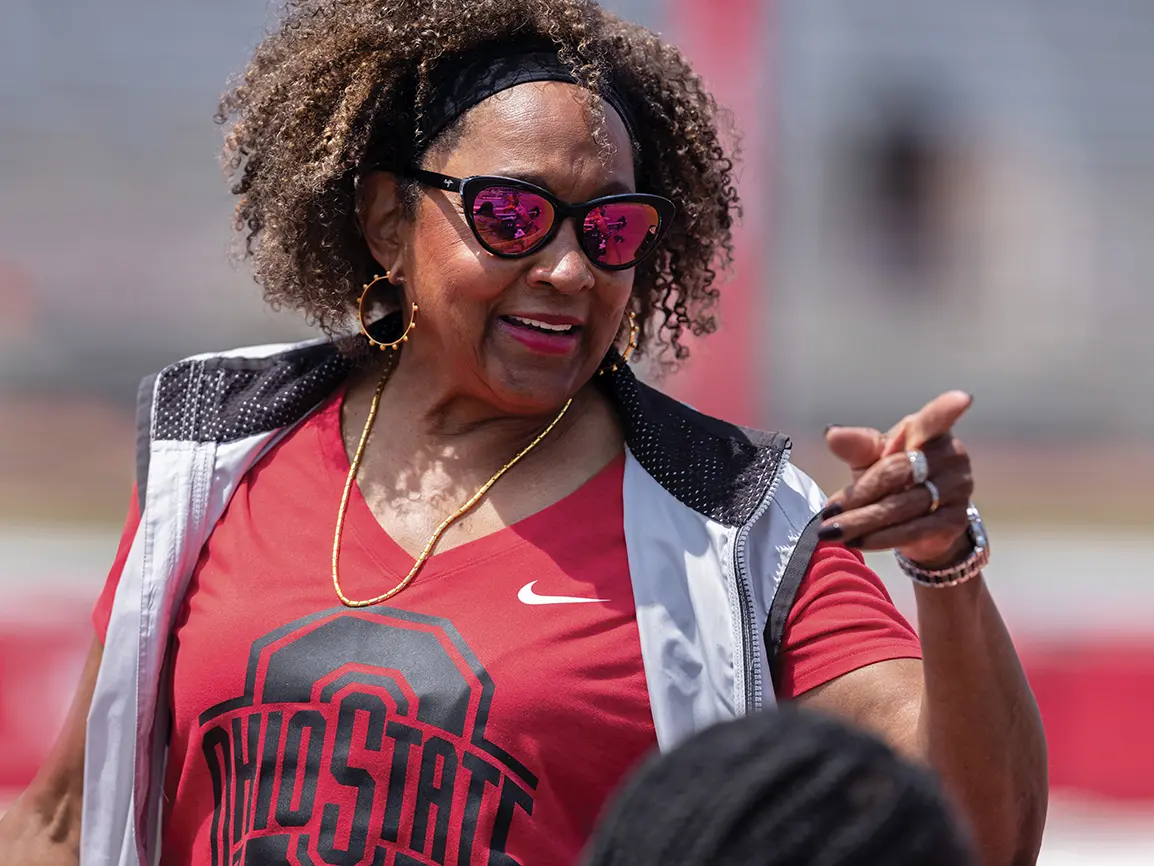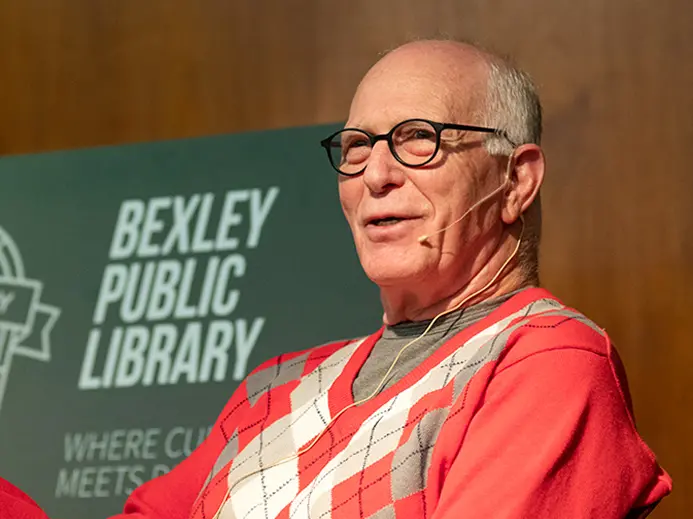She made Ohio State a leader in women’s athletics
With gusto, wit and charm, Phyllis Bailey was persistent in pushing to get women’s sports the respect they deserve.

Associate Athletic Director Miechelle Willis, left, and Phyllis Bailey laugh during the presentation of Bailey’s career achievement award in 2007. (Photo from Ohio State Athletics)
Greetings rang out through the hallways of the retirement home, making it evident that Phyllis Bailey was immersed in community.
Everyone seemed to know her in the Dublin, Ohio, facility on that 2019 summer afternoon. “Hi, Ms. Bailey.” “How are you doing, Coach?”
Bailey, cane in hand, smiled and, on occasion, paused for small talk. The warm interactions had her glowing.
Her connections extended beyond those walls, out to a tight network of supportive friends Bailey made during her 39 years as a coach, instructor and administrator at Ohio State.
She touched countless other lives nationwide as a pioneer for the acceptance, growth and equality of women’s intercollegiate sports.
As an only child from small-town Fairport Harbor, Ohio, Bailey found family — and a broader purpose — in athletics. “If you’re a really good player on a team, you’re not just looking out for yourself, you’re looking around and helping your teammates,” she once said.
Those words are a fitting summation of how Bailey, who died October 1 at age 96, approached her daily service in various roles in Ohio State’s Department of Athletics. Bailey forever looked outside herself with a determination to knock down barriers for female coaches or athletes at the university and nationwide.
Her pioneering spirit and persistence knew no limit as intramural and later varsity coach of the women’s basketball team from 1956 to ’69 and throughout her four decades as an administrator.
“She was always there,” says Sally Dellinger ’68, ’72 MA, a basketball and softball letter winner for the Buckeyes who worked in the university’s School of Physical Activity and Educational Services for nearly 20 years.
Bailey was there to do small favors for individuals. She was there when big problems needed to be addressed for women’s athletics as a whole. And she was there — long after retiring from Ohio State as assistant athletic director in 1994 — to advise anyone or simply be a reassuring presence.
“She’d just show up,” says former Ohio State basketball player Katie Smith ’08, ’14 MS. “She was always curious about what you were doing. She’d keep tabs on you.”
Bailey’s personal touch included a sharp wit that disarmed and also charmed. “She just had a way with people,” Smith says. “She was who she was, which is why we really all cared about her. Her authentic self was comforting and easy to be around.”
Bailey’s tenderness came wrapped in toughness, says Kristin Watt ’86, ’89 JD, who played basketball for the Buckeyes from 1981 to ’85.
“Ohio State was a leader in women’s athletics because of Phyllis,” Watt says. “In the early ’80s, our team got to fly to some games, and we had a nice locker room, and we had two or three pairs of shoes a season that we needed. We had all the same things as the men’s basketball team because Phyllis fought for them.”
Bailey arrived at Ohio State in 1956 and was named women’s basketball coach that year. At that time, each team would have three women posted on the offensive end of the court and three on the defensive end. No players were allowed to cross the center line for fear that running full court would be too rigorous.
Bailey sailed into the storm of such cultural perceptions with enough gusto to eventually help all women’s sports at Ohio State transition from club to varsity status in the 1965–66 academic year.
“She kept at problems until they were solved,” Dellinger says. “She had the patience to wait and see things through. She had plans but knew how to get them done without raising any confrontations.”
Watt says logic, reason and strong will were at the core of Bailey’s diplomatic leadership style. She picked times when she considered it necessary to speak up while also understanding when it was best to coordinate efforts behind the scenes. Never did she seek the limelight.
“There were days,” Watt says, “when she was just like, ‘Ugh, what am I doing?’ But she felt respected at Ohio State, and she felt like she knew she was making a difference.”
Friends knew how much joy Bailey took in the fact that Ohio State’s Department of Athletics now has 17 women’s varsity sports and three co-ed sports. Twelve women’s teams are coached by women.
“Thank you to Phyllis,” Smith says. “She was passionate about her role in pushing forward women’s sports, passionate about the university, passionate about people.”
On that summer day in 2019, Bailey was thinking only about other people when asked to comment on her storied career at Ohio State.
“I was just lucky,” she said. “I was there at the right time to get it done. I had a fun time doing it. I’m getting credit for a lot of stuff that wasn’t up to me, really.”
We know better, Ms. Bailey. We always will.
A storied career
1956: Bailey comes to Ohio State to pursue a PhD and work with women’s sports, then recreational intramural teams. She is appointed coach of the first women’s basketball team.
1958: Ohio State names Bailey coordinator of women’s sports.
1964: Bailey proposes Ohio State acknowledge an intercollegiate women’s sports program, instead of considering those teams as intramural clubs.
1965–66: The university gives women’s athletics varsity status, making Ohio State’s women’s intercollegiate athletic program the first in the Big Ten. Bailey becomes the first varsity coach of women’s basketball.
1968–69: Bailey’s fourth and final varsity basketball team goes 8–0 in the regular season before losing in the first national invitational tournament.
1971: Bailey oversees the establishment of the Association for Intercollegiate Athletics for Women (AIAW), which organizes female intercollege competition for the first time.
1972: The Education and Amendments Act, aka Title IX, is signed into law, giving women equal access to educational opportunities.
1975: Bailey is named an assistant athletic director, a role she held for the next 19 years.
1976: Ohio State grants its first athletic scholarships to women. Under Bailey’s direction, the university also hires physicians and trainers for women’s sports.
1981–82: Women’s sports are officially integrated into the NCAA and Big Ten. Bailey is appointed the university’s first administrator over women’s athletics. The AIAW folds.
1992: Bailey helps transition the Alumnae Society for Women Athletes to the Women’s Varsity O.
1993: The first class of women inducted into the Ohio State Athletics Hall of Fame includes Bailey.
1994: Bailey retires from Ohio State.
2007: Women’s Varsity O presents the inaugural Phyllis Bailey Career Achievement Award to Bailey herself.
2009: Bailey is enshrined in the Ohio Basketball Hall of Fame.
2018: The NCAA Women’s Final Four in Columbus features three sold-out games, with a proud Bailey in attendance.
Support her cause
After her retirement, friends and colleagues established the Phyllis J. Bailey Endowment Fund to support programs and activities that promote women in athletics at Ohio State.



